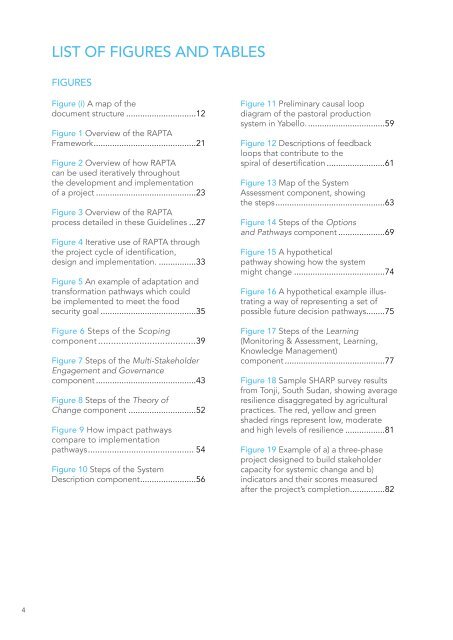DESIGNING PROJECTS IN A RAPIDLY CHANGING WORLD
srun3013fp1
srun3013fp1
You also want an ePaper? Increase the reach of your titles
YUMPU automatically turns print PDFs into web optimized ePapers that Google loves.
LIST OF FIGURES AND TABLES<br />
FIGURES<br />
Figure (i) A map of the<br />
document structure...............................12<br />
Figure 1 Overview of the RAPTA<br />
Framework.............................................21<br />
Figure 2 Overview of how RAPTA<br />
can be used iteratively throughout<br />
the development and implementation<br />
of a project............................................23<br />
Figure 3 Overview of the RAPTA<br />
process detailed in these Guidelines....27<br />
Figure 4 Iterative use of RAPTA through<br />
the project cycle of identification,<br />
design and implementation..................33<br />
Figure 5 An example of adaptation and<br />
transformation pathways which could<br />
be implemented to meet the food<br />
security goal..........................................35<br />
Figure 6 Steps of the Scoping<br />
component.......................................39<br />
Figure 7 Steps of the Multi-Stakeholder<br />
Engagement and Governance<br />
component............................................43<br />
Figure 8 Steps of the Theory of<br />
Change component..............................52<br />
Figure 9 How impact pathways<br />
compare to implementation<br />
pathways............................................. 54<br />
Figure 10 Steps of the System<br />
Description component.........................56<br />
Figure 11 Preliminary causal loop<br />
diagram of the pastoral production<br />
system in Yabello...................................59<br />
Figure 12 Descriptions of feedback<br />
loops that contribute to the<br />
spiral of desertification..........................61<br />
Figure 13 Map of the System<br />
Assessment component, showing<br />
the steps................................................63<br />
Figure 14 Steps of the Options<br />
and Pathways component.....................69<br />
Figure 15 A hypothetical<br />
pathway showing how the system<br />
might change........................................74<br />
Figure 16 A hypothetical example illustrating<br />
a way of representing a set of<br />
possible future decision pathways........75<br />
Figure 17 Steps of the Learning<br />
(Monitoring & Assessment, Learning,<br />
Knowledge Management)<br />
component............................................77<br />
Figure 18 Sample SHARP survey results<br />
from Tonji, South Sudan, showing average<br />
resilience disaggregated by agricultural<br />
practices. The red, yellow and green<br />
shaded rings represent low, moderate<br />
and high levels of resilience..................81<br />
Figure 19 Example of a) a three-phase<br />
project designed to build stakeholder<br />
capacity for systemic change and b)<br />
indicators and their scores measured<br />
after the project’s completion...............82<br />
4


